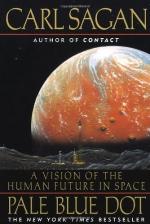
|
| Name: _________________________ | Period: ___________________ |
This test consists of 5 short answer questions, 10 short essay questions, and 1 (of 3) essay topics.
Short Answer Questions
1. Earth will most likely lose contact with the Voyager probes when what happens?
2. When was Neptune discovered?
3. How likely does Sagan think it is that the records on Voyager will eventually be found?
4. Which of the following does Sagan NOT cite as evidence for the age of the universe?
5. Sagan suggests that throughout history, many have claimed that our species is what?
Short Essay Questions
1. What are the distinguishing characteristics of the moon Titan?
2. Why did ancient people believe there could not be any other planets beyond the ones they knew about?
3. How are the Voyager spacecraft able to travel quickly to distant planets?
4. How has the attitude of the Catholic church towards Galileo changed over time?
5. What problems does NASA face in pursuing its missions?
6. Briefly describe the progress made to undermine the geocentric theory.
7. Why does Sagan believe that the image of the "pale blue dot" undermined the "imagined self-importance" of humanity?
8. Why does Saga say he is optimistic about the "human prospect"?
9. What does Sagan think about the failure of the Voyager probes to find life in the solar system?
10. What may have happened to other planets from the early solar system?
Essay Topics
Write an essay for ONE of the following topics:
Essay Topic 1
Venus was once considered to be a "sister planet" to Earth, but is now known to be dramatically different from our own planet.
1) Discuss the characteristics of Venus, including the oddities in its climate, atmosphere, and surface.
2) Explain some of the similarities and differences between Earth and Venus and explain why this planet was once considered a "sister planet" to Earth.
3) Discuss Venus' unique place in the mythologies of ancient cultures around the world, as well as its unique positioning in the night sky as seen from Earth.
Essay Topic 2
Titan is the largest moon of Saturn and the most Earth-like of all of the moons in the solar system, making it a good candidate for finding extraterrestrial life.
1) Describe the characteristics of the moon Titan, including a discussion of its atmosphere and hydrocarbon lakes.
2) Assess the specific characteristics of the moon that make it suitable for life.
3) Discuss Sagan's personal involvement in the study of Titan, its importance to him, and why he believes the moon warrants further study.
Essay Topic 3
Sagan suggests that the colonization of distant worlds is both feasible and critical to humanity.
1) Explain how does Sagan envisions colonization of distant worlds occurring. What would be the motive for such efforts?
2) Discuss some of the targets that Sagan suggests for colonization, including non-planets.
3) Describe why Sagan believes that colonization is critical to securing the safety of the human race.
|
This section contains 861 words (approx. 3 pages at 300 words per page) |

|




